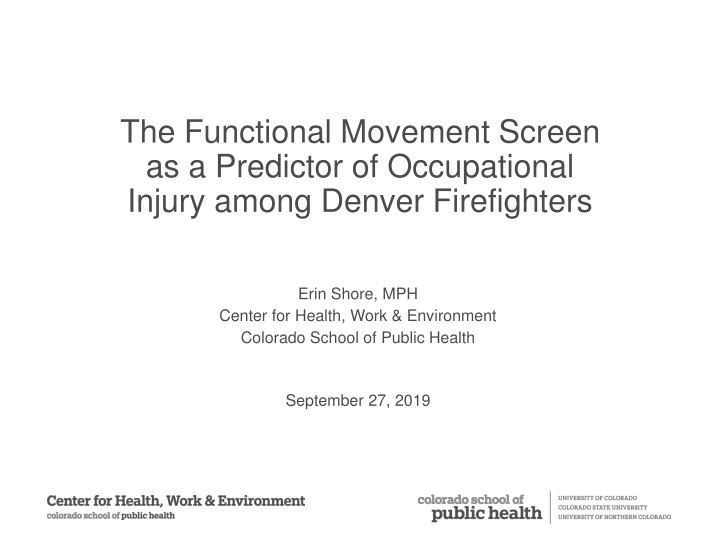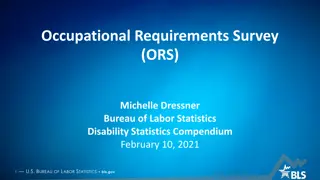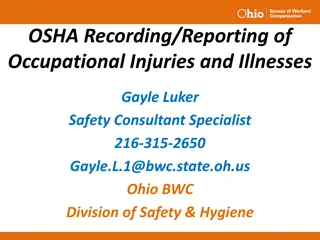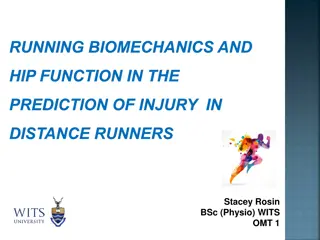Predicting Occupational Injuries Among Denver Firefighters Using Functional Movement Screen
Functional Movement Screen (FMS) has been used to assess fundamental movements in various populations including professional athletes, firefighters, and police officers. This screening tool helps to identify injury risks and track fitness levels and recovery progress. Denver Fire Department incorporated FMS in their wellness initiative for new recruits in 2015. Research shows that composite FMS scores predicted injuries among firefighters, highlighting the importance of proper movement assessment in preventing occupational injuries.
Download Presentation

Please find below an Image/Link to download the presentation.
The content on the website is provided AS IS for your information and personal use only. It may not be sold, licensed, or shared on other websites without obtaining consent from the author.If you encounter any issues during the download, it is possible that the publisher has removed the file from their server.
You are allowed to download the files provided on this website for personal or commercial use, subject to the condition that they are used lawfully. All files are the property of their respective owners.
The content on the website is provided AS IS for your information and personal use only. It may not be sold, licensed, or shared on other websites without obtaining consent from the author.
E N D
Presentation Transcript
The Functional Movement Screen as a Predictor of Occupational Injury among Denver Firefighters Erin Shore, MPH Center for Health, Work & Environment Colorado School of Public Health September 27, 2019
Acknowledgements Collaborators: Miranda Dally, MS Shawn Brooks, PFT Danielle Ostendorf, MS, ACSM-CEP, PhD Maddie Newman, MPH Lee Newman, MD MA Funding: This research was supported by the cooperative agreement U19 OH011227, funded by the National Institute of Occupational Safety and Health in the Centers for Disease Control and Prevention.
Functional Movement Screen (FMS) The FMS was developed to assess an individual s fundamental movements Proper form on these tasks is needed to improve flexibility, power, and strength FMS can be used recognize injury risk and be a tool to track fitness level and/or injury recovery
Functional Movement Screen (FMS) 1. Deep Squat 2. Hurdle Step 3. In-line Lunge 4. Shoulder Mobility 5. Active Leg Raise 6. Trunk Stability Push-up 7. Rotary Stability
FMS as a predictor of injuries Composite FMS score predicted injury in: Mixed evidence that composite FMS score predicts injury in: Professional athletes Firefighters Collegiate athletes Police officers Secondary school athletes Military members
Injuries among firefighters Nationally-2017: Locally-2016: 58,835 workplace injuries 93 Denver firefighters occurred sustained a workplace injury 48% of these were strain, sprain, and muscular pain Strain, sprain, and muscular pain injuries accounted for 56% of all non fireground injuries
FMS Use among Denver Firefighters The Denver Fire Department (DFD) began using the FMS with new recruits in 2015 The FMS test was part of their wellness initiative
Study Purpose Determine if an FMS Score of 14 or less was predictive of an occupational injury among Denver firefighters Injuries defined as a workers compensation claim
Hypotheses Hypothesis 1: An FMS Score of 14 or less will be associated with a WC Claim compared to no claim Hypothesis 2: An FMS Score of 14 or less will be associated with an overexertion WC claim compared to no claim or another type of claim Hypothesis 3: Lower scores on the deep squat, shoulder mobility, and rotary stability sub-tests will be associated with an occupational injury
Study Population 1,021 observations in FMS Dataset Kept only the initial FMS score. Deleted 176 subsequent tests 745 observations when merged with claims dataset Deleted 164 observations where the claim occurred before the FMS test 581 observations in analysis dataset 393 no claim 188 claims
Study Population 1,021 observations in FMS Dataset Kept only the initial FMS score. Deleted 176 subsequent tests 745 observations when merged with claims dataset Deleted 164 observations where the claim occurred before the FMS test 581 observations in analysis dataset 393 no claim 188 claims
Sample Demographics Overall Mean age 38 years Mostly male 93% Mean height 70 inches Mean weight 194 lbs Resting heart rate 69 beats per minute Mean Blood Pressure 122 / 76 VO2 Max 45 mL/kg/min Number of claims 188 (32%)
Distribution of FMS Scores 120 105102 99 100 75 80 Count 60 51 49 43 40 20 20 12 12 9 2 1 1 0 1 2 3 4 5 6 7 9 10 11 12 13 14 15 16 17 18 19 20 21 FMS Composite Score 8
FMS Scores by Claim Status: Any Claim Table 1. FMS Scores and Sub-scores by Claim Status Any Claim vs. No Claim Overall N = 581 Claim N = 188 No Claim N = 393 Mean (SD) Mean (SD) Mean (SD) Composite Score 14.9 (2.3) 14.8 (2.3) 14.9 (2.2) Deep Squat 2.0 (0.6) 2.0 (0.6) 2.1 (0.6) Hurdle Step 2.0 (0.3) 2.0 (0.3) 2.0 (0.3) In-line Lunge 2.0 (0.7) 2.0 (0.6) 2.0 (0.7) Shoulder Mobility 2.1 (0.7) 2.1 (0.8) 2.1 (0.7) Active Leg Raise 2.2 (0.6) 2.3 (0.6) 2.2 (0.6) Trunk Stability Push-up 2.7 (0.6) 2.6 (0.6) 2.7 (0.6) Rotary Stability 1.8 (0.4) 1.9 (0.4) 1.8 (0.4)
FMS Scores by Claim Status: Over-exertion Claim Table 2. FMS Scores and Sub-scores by Claim Status Over-exertion claim vs. No Claim, Any Claim Overall N = 581 Over-exertion Claim N = 72 Mean (SD) No Claim, Other Claim N = 509 Mean (SD) Mean (SD) Composite Score 14.9 (2.3) 14.7 (2.2) 14.9 (2.3) Deep Squat 2.0 (0.6) 2.0 (0.5) 2.1 (0.6) Hurdle Step 2.0 (0.3) 2.0 (0.3) 2.0 (0.3) In-line Lunge 2.0 (0.7) 1.9 (0.7) 2.0 (0.7) Shoulder Mobility 2.1 (0.7) 2.0 (0.7) 2.1 (0.7) Active Leg Raise 2.2 (0.6) 2.3 (0.6) 2.2 (0.6) Trunk Stability Push-up 2.7 (0.6) 2.7 (0.6) 2.7 (0.7) Rotary Stability 1.8 (0.4) 1.9 (0.4) 1.8 (0.4)
Logistic Regression Results Claim vs. No Claim FMS < 14: OR = 1.27 (95% CI 0.88-1.83) Age: 0.96 (95%CI 0.94-0.98) Over-exertion Claim vs. No Claim, other claim FMS < 14: OR = 1.33 (95% CI 0.81 - 2.21) Age: 0.97 (95% CI 0.94 - 0.99)
ROC Curves Over-exertion Claim vs. No Claim, Other Claim Claim vs. No Claim
Sensitivity and Specificity: Claim vs. No Claim Table 3. Sensitivities and Specificities for Claim vs. No claim FMS Score Sensitivity Specificity 10.0 0.48 0.96 12.0 0.17 0.87 13.5 0.23 0.77 14.5 0.42 0.61 15.5 0.59 0.42 16.5 0.75 0.24 17.5 0.88 0.11 18.5 0.98 0.03 20.0 1.00 0.0
Sensitivities and Specificities: Over-exertion claim vs. No claim, other claim Table 4. Sensitivities and Specificities for Over-exertion Claim vs. No Claim, Other Claim FMS Score Sensitivity Specificity 10.0 0.06 0.96 12.0 0.13 0.85 13.5 0.21 0.76 14.5 0.44 0.60 15.5 0.65 0.43 16.5 0.81 0.25 17.5 0.89 0.11 18.5 0.99 0.03 20.0 1.00 0.00
Conclusions In this sample, the FMS is not predictive of an occupational injury Limitations Convenience sample Narrow distribution of FMS score
Stay Connected chwe.ucdenver.edu chwe.ucdenver.edu @CHWENews @CHWENews @CHWENews @CHWENews























